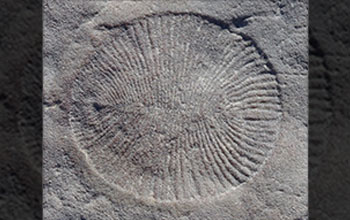Multimedia Gallery
Study sheds light on Earth’s first animals (Image 3)
A specimen of Dickinsonia costata, one of the first mobile animals to exist on Earth, from the South Australia Museum. [Image 3 of 3 related images. Back to Image 1.]
More about this image
Researchers at the University of California, Riverside, are studying the Ediacaran-era fossil animal Dickinsonia to unlock the secrets of early life. Dickinsonia lived more than 550 million years ago, when the oceans were teeming with these flat, soft-bodied creatures that fed on microbes and algae and could grow as big as bathmats.
Research by Scott Evans, a graduate student in the Department of Earth Sciences, and Mary Droser, a professor of paleontology, both of UC-Riverside's College of Natural and Agricultural Sciences, shows that Dickinsonia developed in a complex, highly regulated way using a similar genetic toolkit to today’s animals. The study helps place Dickinsonia in the early evolution of animal life and shows how the large, mobile sea creature grew and developed.
Paleontologists are particularly interested in Dickinsonia because they are the first animals to become large and complex and to move around and form communities. These flat, oval-shaped creatures ranged in size from less than an inch to several feet and are characterized by a series of raised bands -- known as modules -- on their surface.
Scientists have debated the taxonomic status of Dickinsonia for years, placing it with fungi, marine worms and jellyfish, to name a few, but now, it is generally accepted as an animal (now extinct).
"Part of this study was trying to put Dickinsonia in context in the development of early life. We wanted to know if these creatures were part of a group of animals that survived or a failed evolutionary experiment. This research adds to our knowledge about these animals and our understanding of life on Earth as an artifact of half a billion years of evolution," said Droser.
For the study, the researchers travelled to South Austrailia's desert outback -- once underwater and now filled with an abundance of Ediacaran fossils, where they measured the size, shape and structure of almost 1,000 specimens of Dickinsonia costata, paying particular attention to the number and size of modules. The study showed that Dickinsonia's development -- particularly that of the modules -- was complex and systematic to maintain the animals' oval shape. New modules accumulated by a process called terminal addition, suggesting Dickinsonia developed in a related way to bilaterians, a complex group that display bilateral symmetry. But the researchers don't believe Dickinsonia was ancestrally related to bilaterians, since it lacked other features that most bilaterians share, most notably a mouth, gut and anus.
"Although we saw some of the hallmark characteristics of bilateral growth and development, we don't believe Dickinsonia was a precursor to today's bilaterians, rather that these are two distinct groups that shared a common set of ancestral genes that are present throughout the animal lineage," Evans said. "Dickinsonia most likely represents a separate group of animals that is now extinct, but can tell us a lot about the evolutionary history of animals."
This research was supported in part by the National Science Foundation (grant OISE 14-14911).
To learn more about this research, see the UC-Riverside news story UCR study sheds light on Earth's first animals. (Date image taken: 2014; date originally posted to NSF Multimedia Gallery: Feb. 27, 2018)
Credit: Scott Evans, UC-Riverside
Images and other media in the National Science Foundation Multimedia Gallery are available for use in print and electronic material by NSF employees, members of the media, university staff, teachers and the general public. All media in the gallery are intended for personal, educational and nonprofit/non-commercial use only.
Images credited to the National Science Foundation, a federal agency, are in the public domain. The images were created by employees of the United States Government as part of their official duties or prepared by contractors as "works for hire" for NSF. You may freely use NSF-credited images and, at your discretion, credit NSF with a "Courtesy: National Science Foundation" notation.
Additional information about general usage can be found in Conditions.
Also Available:
Download the high-resolution JPG version of the image. (387.2 KB)
Use your mouse to right-click (Mac users may need to Ctrl-click) the link above and choose the option that will save the file or target to your computer.



